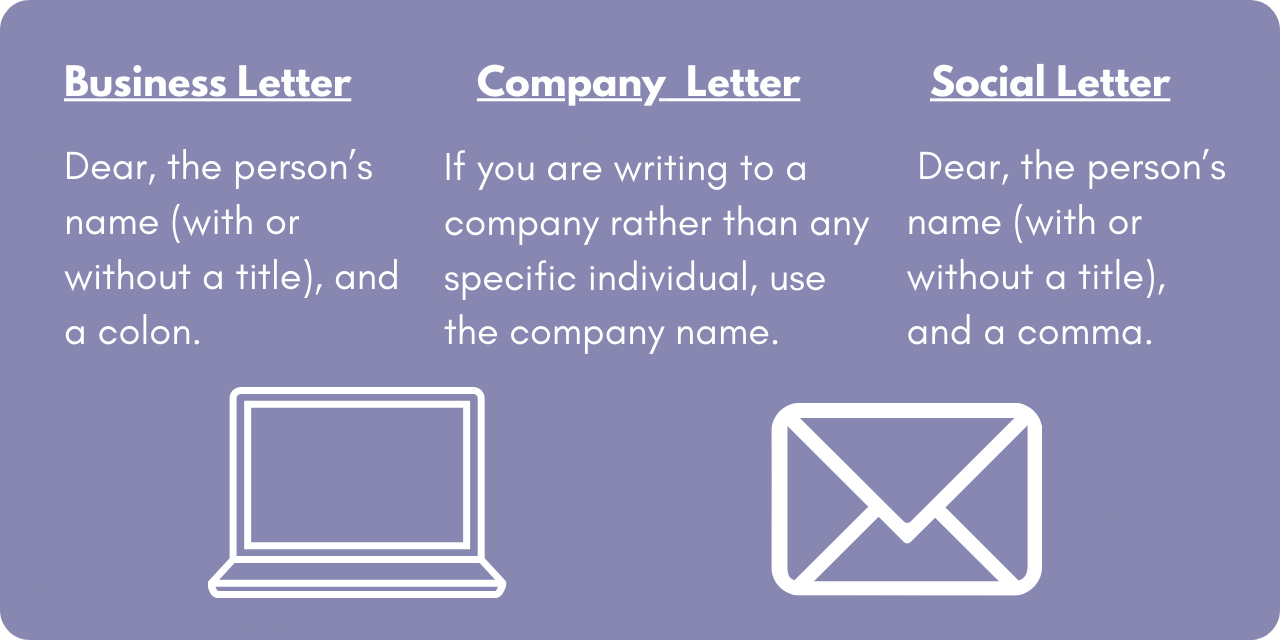This post is all about the etiquette of salutations (greetings). We discuss both business letter salutation and email salutation. It’s dedicated to the many who have visited this blog in search of tips on how to begin a letter.

Rules for Business Letters
The standard way to open a business letter is with Dear, the person’s name (with or without a title), and a colon, like this:
- Dear Louise:
- Dear Ms. Chu:
- Dear Mr. and Dr. Paige:
- Dear Professor Amato:
- Dear Patrick:
(For more discussion of Dear, see my post “Do I Have to Call You Dear?”)
The standard way to open a social business letter is with Dear, the person’s name (with or without a title), and a comma, like this:
- Dear Nigel,
- Dear Dr. Tarabi,
- Dear Reverend Jans,
A social business letter is social or personal rather than business-focused; for example, letters of condolence, personal congratulations (for weddings, births, promotions, and other celebrations), and thank yous.
If you don’t know the reader well or if the letter or the relationship is formal, use a title and a last name (Dear Ms. Browne). Otherwise, use the first name (Dear Gila).
Unless you are certain that a woman prefers Miss or Mrs., use the title Ms.
If you are writing to two people, use both names in your salutation, like this:
- Dear Mr. Trujillo and Ms. Donne:
- Dear Alex and Drenda,
Never spell out the titles Mr., Ms., Mrs., and Dr. Do spell out these titles and similar ones:
- Professor, Dean, Sister, Rabbi, Imam, Senator, Governor, Captain, Admiral, Judge
If you don’t know a person’s gender, use the full name rather than a title:
- Dear Dana Simms:
- Dear T.K. Spinazola:
If you don’t know a person’s name or gender, avoid “To whom it may concern.” Instead, use the job title or a generic greeting:
- Dear Recruiter:
- Dear Claims Adjustor:
- Dear Sir or Madam:
If you are writing to a company rather than any specific individual, use the company name:
- Dear Syntax Training: (This is considered slightly informal.)
Rules for Email
For formal email (that is, email used as a business letter), follow rules 1-7 above. Otherwise, use less formality with greetings like these:
- Dear Han,
- Hi Eva,
- Hello Kwasi,
- Hi all,
- Good morning, Ann,
If you use only the reader’s name without a greeting, be sure to open with a positive sentence so your message does not come across as cold:
Sue,
Thanks for your help with the order.
Brooke:
I’m happy to provide the information you requested.
For informal messages, you may also insert the greeting on the same line as the opening sentence, like this:
- Hello, David. I hope you had a great vacation.
- Good morning, Wanda. I am following up on this morning’s meeting.
Or just use the person’s name in the opening sentence, like this:
- Yiota, you were right about the prices.
If you are looking for a desk reference that covers much more about business letters, email, reports, salutation, etc., I recommend The Gregg Reference Manual 11th Edition, also known as Gregg. I used Gregg to check the rules and recommendations above.
Further reading: More About Salutations






